You’ll find today’s gemstone setting defined by revolutionary techniques like invisible setting, where precision-cut grooves interlock stones without visible metal, and tension setting that uses platinum’s strength to create floating effects. Micro-pavé work demands 0.1mm tolerances for stones smaller than 1.5mm, while CAD software and laser technology enable previously impossible designs. These methods combine with sustainable practices using recycled metals and lab-grown gems. Advanced quality control and specialized tools guarantee each piece meets rigorous professional standards that’ll transform your understanding of modern jewelry craftsmanship.
Evolution of Contemporary Setting Methods in Modern Jewelry
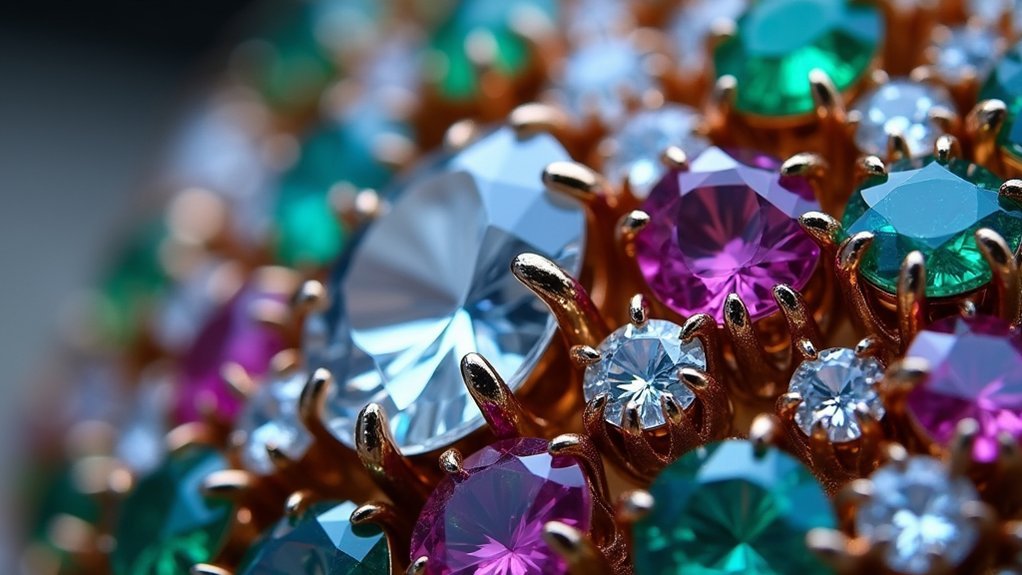
As modern jewelry design has pushed beyond traditional boundaries, contemporary gemstone setting methods have revolutionized how stones are secured and displayed.
You’ll find tension setting creates dramatic floating effects by gripping stones between metal bands without visible prongs. Flush setting embeds gems level with metal surfaces, delivering sleek minimalist aesthetics while preventing snags.
Modern techniques now utilize stronger metals like platinum, enabling jewelers to accommodate unique cuts while maintaining structural integrity.
Advanced craftsmanship shines through pavé setting, where tiny stones are meticulously placed using precision tools to maximize sparkle.
Custom jewelry has sparked demand for unconventional approaches that showcase individual preferences.
These contemporary gemstone setting innovations prioritize both visual appeal and durability, allowing you to wear pieces that appear impossibly delicate yet remain remarkably secure through everyday use.
Precision Engineering Behind Pavé and Micro-Pavé Techniques
When you’re working with pavé and micro-pavé techniques, you’ll need to master stone size precision standards that determine exactly how small gemstones can be while maintaining structural integrity.
You’ll also discover that metal framework engineering methods require calculating precise hole depths and spacing to create that seamless surface effect.
Finally, you’ll find that tool technology advancement systems have revolutionized these settings, giving you access to specialized equipment that makes intricate placement possible where it once seemed impossible.
Stone Size Precision Standards
While many jewelry enthusiasts admire the dazzling surface of pavé and micro-pavé settings, few realize the extraordinary precision engineering that creates this seamless carpet of sparkling stones.
Stone size precision standards demand pavé stones measure 1.5mm to 2.5mm diameter, while micro-pavé requires stones smaller than 1.5mm. You’ll find that maintaining tight tolerances of 0.1mm when drilling holes guarantees each gemstone in place fits perfectly without movement.
Advanced technology like laser engraving and CAD systems enables jewelers to achieve intricate designs with unprecedented accuracy.
High-quality metals such as 18k gold or platinum provide essential strength for secure stone retention. Skilled artisans use specialized tools to manipulate metal prongs precisely, creating pavé settings that maintain a seamless appearance while firmly holding every stone.
Metal Framework Engineering Methods
Behind every flawless pavé surface lies a complex metal framework that requires surgical precision in its engineering.
You’ll find that modern techniques in gemstone setting involve drilling holes slightly smaller than your stones’ girdles, creating secure fits while maximizing their reflective surface. When you’re working with micro-pavé, you’ll need advanced skills to position smaller gems closely together, demanding meticulous attention to your metal framework’s details.
Your pavé settings rely on tiny gold prongs that secure stones while minimizing visible metal, enhancing the gemstones’ visual impact.
Laser technology revolutionizes precision engineering by enabling you to create intricate designs previously impossible. These innovations push traditional boundaries, accommodating today’s demand for luxurious jewelry through exceptional craftsmanship and technological advancement.
Tool Technology Advancement Systems
As technology evolves at breakneck speed, you’ll discover that modern tool technology advancements have transformed pavé and micro-pavé setting from an artisan’s guessing game into a precise science.
Precision engineering now enables jewelers to create intricate pavé settings with unparalleled accuracy, ensuring gemstones fit securely while maximizing light exposure.
Three revolutionary innovations define today’s setting techniques:
- Computer-aided design (CAD) software allows you to visualize complex designs before production, minimizing errors and material waste.
- Laser cutting and drilling create precise holes in metal settings that reduce metal visibility and enhance aesthetic appeal.
- Advanced microscopic tools enable meticulous stone placement with minimal surface pressure, preventing damage.
These innovations, combined with stronger materials, improve durability without compromising the jewelry’s integrity over time.
Invisible Setting Technology for Seamless Stone Placement
When you’re seeking the ultimate in sophisticated gemstone presentation, invisible setting technology delivers an unparalleled seamless appearance that eliminates visible metal between stones.
This advanced craftsmanship technique requires creating precise grooves on each gemstone’s underside that interlock with a specially designed metal frame beneath. The meticulous attention to detail guarantees perfect stone placement while maintaining structural integrity.
Precision-cut grooves beneath each stone interlock seamlessly with hidden metal frameworks, ensuring flawless alignment and enduring structural stability.
You’ll find this technique works exceptionally well with square or rectangular cuts like princess and baguette diamonds, which align tightly for a polished look.
The labor-intensive process demands exceptional skill, making invisible setting a hallmark of high-end jewelry. When executed properly, you’ll achieve a continuous surface that creates stunning visual impact and modern elegance.
Tension Setting Innovations Using Advanced Metal Compression

You’ll find that platinum pressure mechanisms represent the pinnacle of tension setting technology, utilizing the metal’s exceptional strength and malleability to create precise compression forces that securely grip gemstones.
The engineering behind these systems focuses on strategic metal stress distribution, where carefully calculated pressure points transfer forces evenly throughout the setting structure.
This advanced approach guarantees you’re getting ideal stone security while maintaining the signature floating appearance that makes tension settings so visually striking.
Platinum Pressure Mechanisms
While traditional settings rely on prongs or bezels to secure gemstones, tension settings revolutionize jewelry design through platinum’s exceptional strength and precise metal compression.
You’ll find that platinum’s durability creates the ideal foundation for this innovative technique, where gemstones appear to float magically within the setting.
The platinum pressure mechanism works through three critical elements:
- Precision groove cutting – Creates exact channels that grip your gemstone securely
- Calculated metal stress – Applies maximum pressure without compromising the stone’s integrity
- Strategic light pathways – Maximizes brilliance by eliminating traditional obstructions
This modern jewelry design technique works best with hard gemstones like diamonds and sapphires.
You’ll appreciate how the minimalist aesthetic emphasizes your stone’s natural beauty while the advanced metal compression guarantees lasting security.
Metal Stress Distribution
Advanced metal compression transforms how stress flows throughout tension settings, distributing forces across multiple contact points to prevent dangerous pressure concentrations.
You’ll find that metal pressure is used through precisely engineered grooves and cutouts that direct forces evenly around the gemstone’s perimeter. These advanced metal compression techniques require platinum or titanium’s exceptional tensile strength to securely hold the gemstone without traditional bezels.
Stress distribution becomes critical when working with hard gemstones like diamonds and sapphires, which can withstand the applied forces. The engineering creates a stunning visual effect where stones appear suspended in mid-air.
However, you must prioritize regular maintenance since metal integrity directly affects your gemstone’s security. Professional inspections guarantee the stress remains properly distributed, preventing potential failure points that could compromise the setting’s structural reliability over time.
Computer-Aided Design Transforming Custom Setting Creation
Since traditional hand-setting methods often limit the complexity of custom designs, Computer-Aided Design has revolutionized how jewelers approach gemstone setting creation.
You can now create precise 3D models that enable intricate designs previously impossible by hand. CAD software guarantees accuracy in measurements, assuring perfect stone fit for both security and aesthetics.
Modern CAD applications transform your design process through:
- Rapid prototyping – You’ll make quick adjustments and iterations before production, greatly reducing design time.
- Material simulation – You can visualize the final product with various metals and finishes before committing.
- 3D printing integration – You’ll produce wax models for casting, streamlining the shift from digital concept to physical jewelry.
This technology enhances your ability to create custom gemstone settings with unprecedented precision and creative freedom.
Laser Welding Applications in Delicate Setting Work

When you’re working with fragile gemstones, laser welding gives you unprecedented control over heat application, allowing you to make precise joins without risking thermal damage to your stones.
You’ll find that this micro-welding technique protects even the most heat-sensitive gems by concentrating energy in tiny, controlled bursts exactly where you need them.
This precision heat control transforms challenging settings like tension mounts and micro-pavé work from risky endeavors into manageable procedures.
Precision Heat Control Benefits
Every laser welding application in jewelry making centers on one critical advantage: the ability to deliver heat with surgical precision to areas measuring just millimeters across.
This precision heat control transforms how you approach delicate setting work, enabling intricate designs that were previously impossible or impractical.
When you’re working with laser welding for gemstone settings, you’ll experience three key benefits:
- Minimal heat zones that protect surrounding metals and stones from thermal damage
- Enhanced durability through stronger molecular bonds without visual disruption
- Design flexibility allowing complex assemblies without complete disassembly
Your jewelry piece maintains its visual aesthetics while gaining structural integrity.
The controlled heat application means you can repair, adjust, or create settings with confidence, knowing the laser’s accuracy preserves both the gemstone’s security and the piece’s original beauty.
Micro-Welding Stone Protection
Although traditional soldering techniques require significant heat that can damage delicate gemstones, laser welding’s micro-focused beam creates protective barriers around your stones while forming permanent metal bonds.
This advanced method enables you to achieve precise settings without compromising gemstone protection, as the concentrated light energy minimizes the heat affected zone around vulnerable stones.
You’ll find laser welding particularly valuable when creating intricate designs featuring micro-pavé or cluster arrangements.
The technique allows you to secure small stones without adding excessive bulk while maintaining structural integrity.
Your delicate settings benefit from superior durability through long-lasting bonds that withstand daily wear.
This precision technology revolutionizes how you approach complex jewelry construction, ensuring both aesthetic appeal and functional longevity in your finished pieces.
3D Printing Revolution in Setting Prototype Development
Since traditional prototyping methods can take weeks or even months to produce a single test piece, 3D printing has fundamentally transformed how jewelers approach gemstone setting development.
You’ll find that this technology creates intricate designs with unprecedented precision and speed, revolutionizing prototype development across the jewelry design industry.
3D printing offers you three game-changing advantages:
- Rapid prototyping capabilities – Test multiple design iterations quickly before final production
- Complex geometry creation – Achieve customized settings impossible with traditional methods
- Enhanced client communication – Present tangible models for evaluation before material commitment
Advanced materials like resin and metal-infused filaments now mimic traditional metals’ appearance and durability.
You can explore creative possibilities while ensuring ideal gemstone fit and aesthetic appeal through this revolutionary approach.
Advanced Flush Mount Techniques for Minimalist Designs
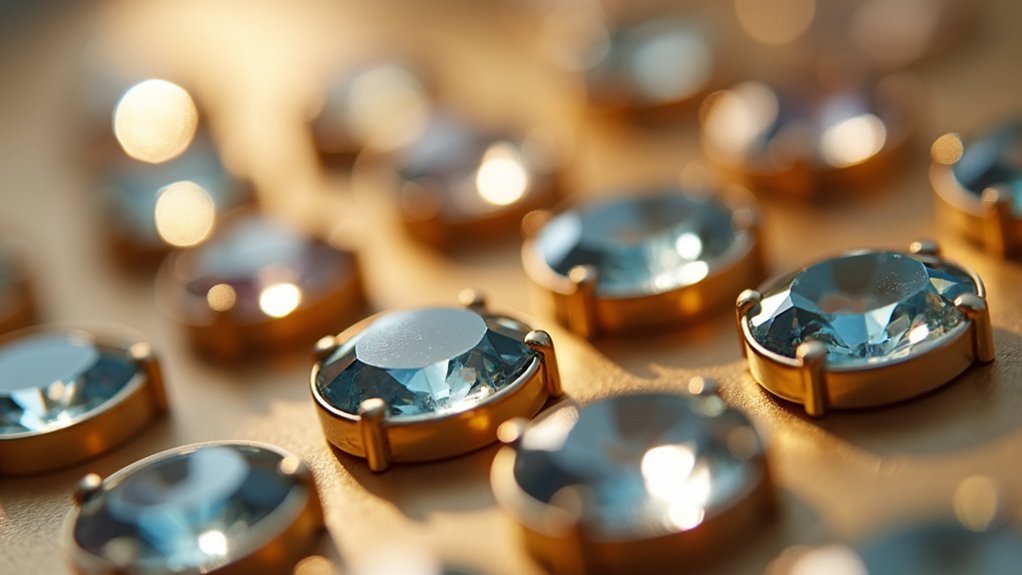
While 3D printing excels at creating complex prototypes, flush mount techniques represent the opposite philosophy—achieving maximum impact through sophisticated simplicity.
Advanced flush mount techniques embed stones directly into metal surfaces, where the gemstone appears perfectly level with the jewelry’s top. You’ll create a minimalistic appearance by using specialized burs to drill holes slightly smaller than your stones, ensuring they sit securely flush.
Specialized burs create perfectly sized holes, allowing gemstones to sit flush with metal surfaces for seamless, minimalistic jewelry designs.
This seamless design approach makes modern designs incredibly durable for daily wear. The technique provides exceptional durability and stability since stones can’t catch on clothing or become dislodged.
You’ll discover creative freedom working with various stone shapes and sizes while maintaining that clean, sophisticated aesthetic that’s transformed contemporary jewelry into wearable art.
Hybrid Setting Methods Combining Traditional and Modern Approaches
When you master hybrid setting methods, you’re fundamentally creating jewelry that bridges centuries of craftsmanship with cutting-edge innovation.
These approaches combine traditional techniques like bezels and prongs with modern innovations such as tension settings, delivering enhanced security and visual appeal.
You’ll leverage advanced technology including laser welding and CAD software to achieve precision while maintaining artisanal quality.
Consider these powerful hybrid combinations:
- Tension-style bezel settings that merge strength with floating gemstone effects
- Micro-pavé integrated with channel settings for continuous sparkle and secure stone placement
- Bar settings alongside pavé elements creating unique texture contrasts
This creative freedom allows you to design pieces reflecting both classic elegance and contemporary trends, resulting in jewelry that appeals to modern consumers seeking distinctive, secure settings.
Specialized Tools and Equipment for Contemporary Setters
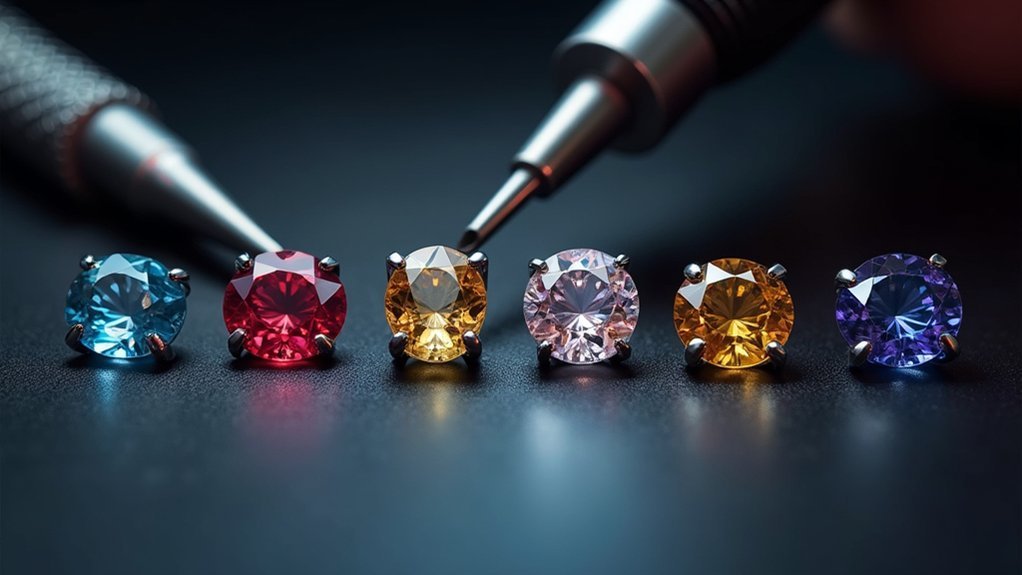
Modern gemstone setting demands precision tools that transform complex designs from concept to reality with unprecedented accuracy.
You’ll find laser welding technology essential for precise assembly, allowing secure settings without stone damage while enabling intricate designs previously impossible. Measuring gemstones requires micrometers and calipers for exact fitting across various sizes and shapes.
Your toolkit should include ultrasonic cleaners that thoroughly clean stones before setting, maximizing brilliance and preventing debris interference.
Specialized tools like prong pushers and burnishers give you superior control during manipulation and securing processes.
Computer-aided design software revolutionizes your workflow by creating detailed 3D models for testing fit and aesthetics before production.
These setting tools collectively enhance accuracy, reduce errors, and expand creative possibilities, making contemporary gemstone setting more efficient and sophisticated than traditional methods alone.
Quality Control Standards in Modern Setting Workshops
Although sophisticated tools enable precise gemstone setting, rigorous inspection protocols guarantee your finished pieces meet exacting professional benchmarks.
Modern workshops implement thorough quality control standards that transform craftsmanship through systematic verification processes.
Your workshop’s inspection protocols should include:
- Precise measurement tools like digital calipers and laser scanning to verify gemstone security and setting accuracy
- Durability testing through simulated wear conditions that validate long-term performance
- Multi-stage quality checks ensuring each piece meets industry standards before delivery
Organizations like GIA establish essential guidelines for setting techniques and gemstone security.
You’ll benefit from continuous craftsman training that keeps your team updated on evolving methods.
These rigorous inspection protocols guarantee your jewelry withstands everyday use while maintaining aesthetic excellence and structural integrity.
Sustainable Practices in Contemporary Setting Techniques
Three fundamental shifts are transforming how you approach gemstone setting in today’s environmentally conscious market.
You’re now incorporating recycled metals and pursuing ethical sourcing to minimize environmental impact while maintaining quality standards.
Lab-grown gemstones offer you sustainable alternatives that reduce ecological footprints without compromising brilliance or durability.
You’ll find 3D printing revolutionizing your workshop efficiency by creating precise settings with minimal material waste.
This technology aligns perfectly with sustainable practices while reducing production costs.
Additionally, you’re adopting eco-friendly adhesives and finishes that protect both your health and the environment during the setting process.
Certifications from organizations like the Responsible Jewellery Council validate your commitment to sustainability, helping you build consumer trust and demonstrate authentic environmental responsibility in your craft.
Future Trends Shaping Next-Generation Setting Methods
How will emerging technologies revolutionize the way you set gemstones in the coming decade?
The future of gemstone setting is being shaped by breakthrough innovations that’ll transform how you create and wear jewelry.
Revolutionary gemstone setting technologies are reshaping jewelry creation, delivering unprecedented customization and sustainable design possibilities for modern artisans.
3D printing enables you to craft intricate, customized settings impossible with traditional methods, while sustainable practices drive the use of recycled metals and ethically sourced stones.
You’ll find innovative materials like lab-created gemstones opening new design possibilities with reduced environmental impact.
Three key trends you can’t ignore:
- Minimalism driving flush settings and tension settings for sleek, modern aesthetics
- Smart jewelry technology integrating wearable tech into functional pieces
- Eco-conscious materials combining sustainability with cutting-edge design
These advances let you create jewelry that’s both technologically sophisticated and environmentally responsible.
Frequently Asked Questions
What Is the Meaning of Stone Setting?
Stone setting’s the method you’ll use to securely place gemstones into jewelry. You’re creating both aesthetic appeal and protection for stones, ensuring they’re held firmly while maximizing their beauty and brilliance.
What Are the Different Gem Setting Styles?
You’ll find four main gem setting styles: prong settings use metal claws for maximum sparkle, bezel settings encircle stones for protection, channel settings place gems between metal walls, and invisible settings create seamless appearances.
What Are the Modern And/Or Ancient Uses for Your Gemstones?
You’ll find gemstones serve ornamental purposes in jewelry, protective talismans in ancient cultures, industrial applications like diamond cutting tools, and alternative healing therapies where stones promote emotional and physical well-being.
In What Ways Are Gems Important in Our Society Today?
You’ll find gems symbolize wealth and status in jewelry, while they’re driving a $48 billion market through ethical sourcing demands. You’re also using them in technology applications and cultural traditions today.
In Summary
You’ll find that modern gemstone setting has transformed into a precision-driven craft where technology meets artistry. You’re witnessing computer-aided design revolutionizing custom work while tension settings push metal compression to new limits. You can’t ignore how invisible setting techniques create seamless stone placement, and micro-pavé work demands microscopic precision. You’re entering an era where sustainable practices and advanced equipment define quality standards, setting the stage for even more innovative future techniques.


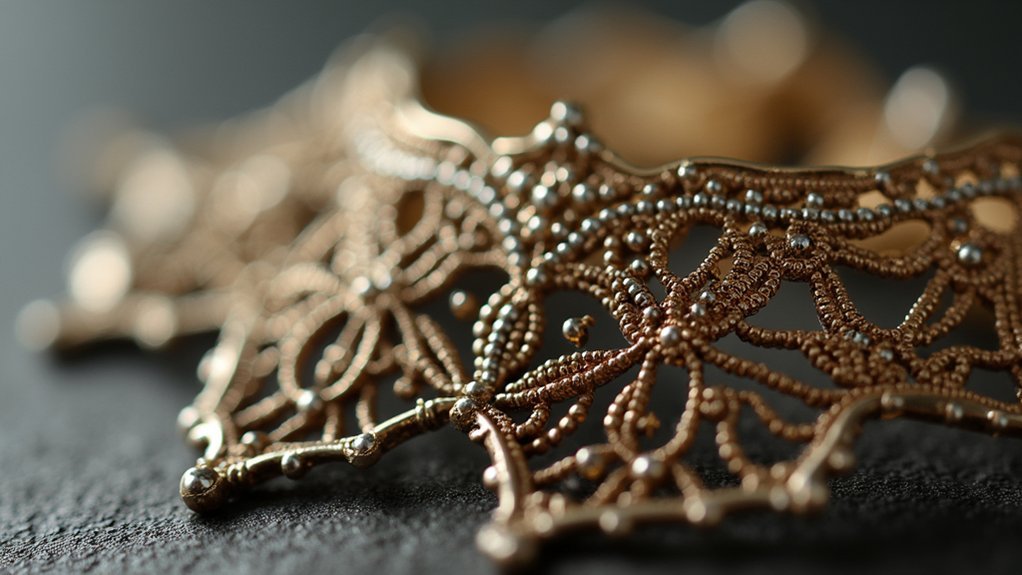
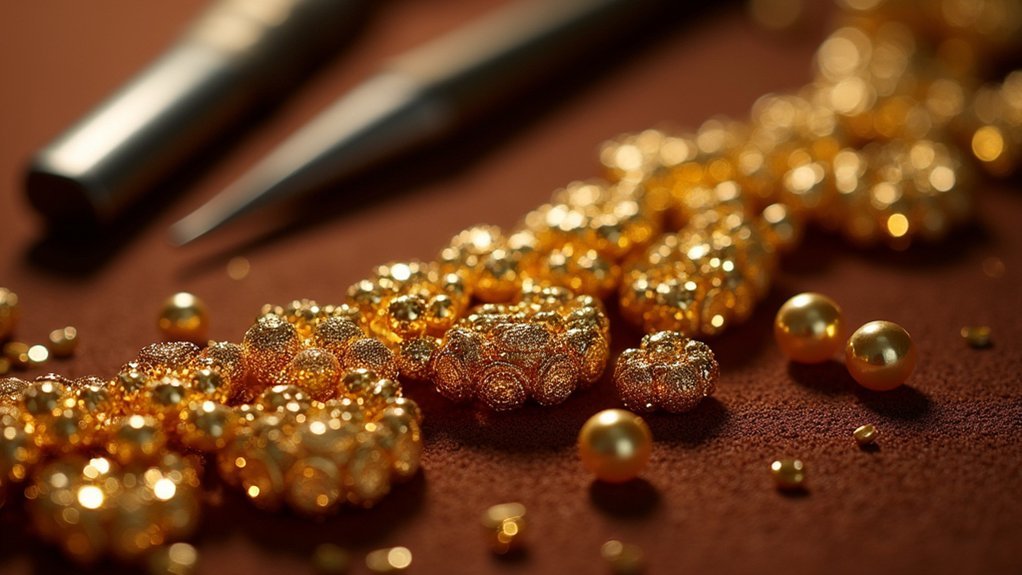
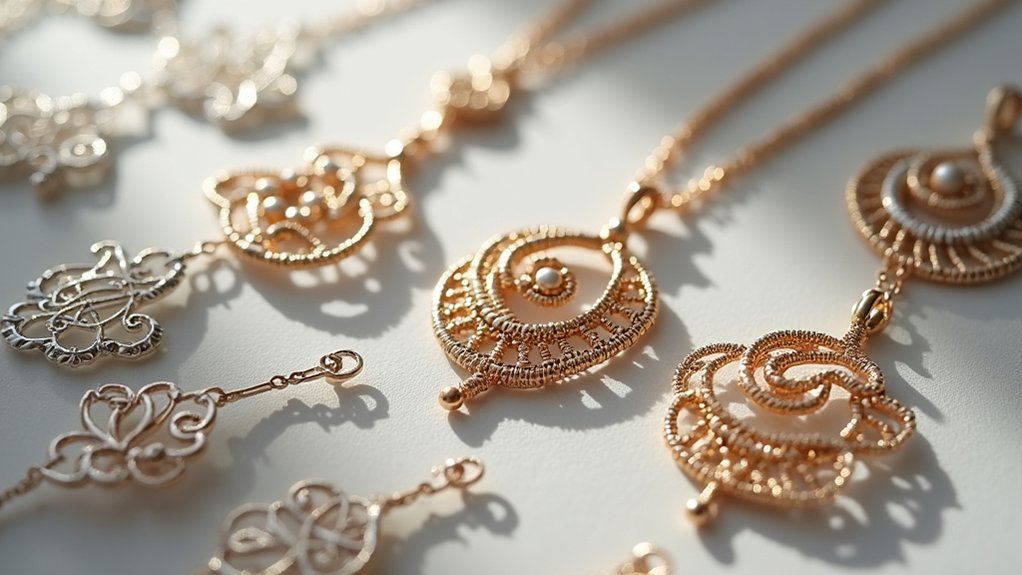
Leave a Reply